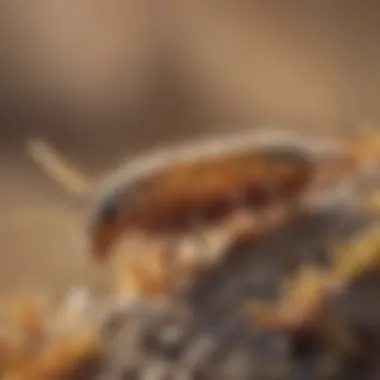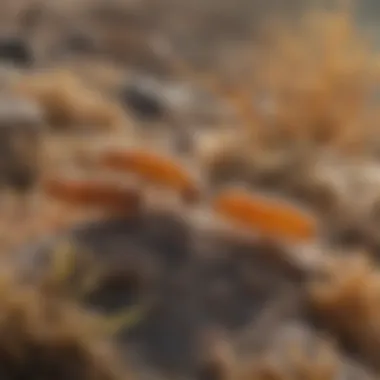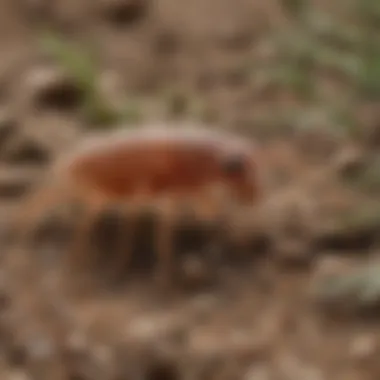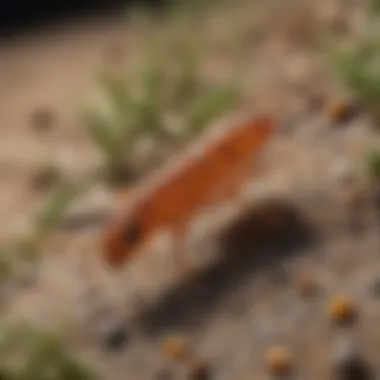Exploring the Ecology and Adaptations of Arid Springtails


Intro
Arid springtails, often referred to by their scientific nomenclature Collembola, are diminutive yet significant players in the fragile ecosystems of dry environments. These soil-dwelling invertebrates are frequently overshadowed by larger soil fauna. Despite their size, they play critical roles in nutrient cycling and soil structure maintenance. Understanding arid springtails is essential, not just for ecologists but for anyone interested in the complexities of arid ecosystems.
The diversity and adaptability of these organisms allow them to thrive in adverse conditions. They exhibit unique physiological adaptations that enable them to survive prolonged dry periods. This discussion will explore the ecological functions, biology, and specialized morphological attributes of arid springtails.
We will examine the intricate relationships they share with soil microorganisms and other invertebrates. In the next sections, we will dive deep into the methodologies used in studying these fascinating creatures, their lifecycle, and the implications of their presence in arid regions.
Additionally, the challenges researchers face while studying arid springtails in their natural habitats will be highlighted. By synthesizing recent research trends, we aim to shed light on the increasingly recognized importance of these tiny organisms.
As we embark on this exploration, it is vital to appreciate the delicate balance that arid springtails help maintain in their environments, serving as indicators of ecological health and resilience.
Foreword to Arid Springtails
Arid springtails represent an intriguing subset of arthropods that thrive in dry environments. Understanding them is essential for comprehending the delicate balance of such ecosystems. These minute creatures contribute significantly to soil health and play a role in nutrient cycling. Their adaptations to arid conditions make them fascinating subjects for study. Not only do they provide insight into ecological dynamics, but they also highlight the complexities of life in extreme habitats.
Defining Springtails
Springtails belong to the class Collembola, characterized by their small size and unique ability to jump. They typically measure between 0.25 to 6 millimeters in length and can be found in various environments, from forest floors to deserts. Their namesake, the "furcula," is a tail-like appendage that allows them to spring away from danger. This trait has evolved as a defense mechanism against predators. Springtails are a critically important component of the soil ecosystem, aiding in organic matter breakdown and supporting overall soil structure.
Diversity of Arid Springtails
Arid springtails are a diverse group of species adapted to survive in harsh conditions. Most are found in regions with limited moisture and extreme temperatures. They exhibit various physiological and behavioral traits to manage these challenges.
Some key diversity points include:
- Morphological Variations: Different species present a range of body shapes and colors. These variations often correlate with the specific environments they inhabit.
- Ecological Niches: Each species occupies a specific niche within the ecosystem, providing unique functions such as decomposition and nutrient recycling.
- Local Adaptations: Some springtails have developed specialized adaptations, like cuticular waterproofing, to minimize water loss in arid conditions.
In studying arid springtails, researchers gain insights into their evolutionary pathways and ecological significance. The exploration of their diversity reveals much about the resilience of life in some of the most unforgiving places on Earth.
Taxonomy and Classification
The section on taxonomy and classification is vital for understanding arid springtails' ecological and biological significance. Taxonomy provides a structured framework that helps in identifying and categorizing these organisms based on shared characteristics. This understanding aids researchers in recognizing the diversity within arid springtails and their relationships to other species. Furthermore, clarity in classification allows for more effective communication among scientists and fosters a deeper understanding of ecological roles within arid ecosystems.
Phylum and Classifications
Arid springtails belong to the phylum Hexapoda, a diverse group within the animal kingdom that includes insects and closely related arthropods. One crucial aspect of their classification is their placement under the class Collembola. This class primarily consists of small, wingless arthropods that thrive in soil and leaf litter. Due to their size and habitat, springtails often go unnoticed, yet they play substantial roles in soil health and nutrient recycling.
Within the class Collembola, arid springtails are classified into various orders and families. The classification is based on both morphological and ecological traits, offering insights into their adaptability to extreme conditions. This adaptability is crucial for survival in arid environments, where moisture is limited. The classification also assists in studying evolutionary relationships and understanding how these springtails have adapted to their specific habitats.
Key Families of Arid Springtails
Several families within the class Collembola are particularly significant regarding arid springtails. These families exhibit distinct adaptations that enable them to endure harsh conditions.
- Sminthuridae: This family includes many species that exhibit behavioral and physiological adaptations for desiccation resistance. They are often found in dry soils and can quickly mobilize to seek moisture when conditions become extreme.
- Entomobryidae: Known for their elongated bodies and long antennae, this family is adaptable to a range of habitats. Some species have been documented in arid environments and contribute to soil aeration and microbial activity.
- Hypogastruridae: Members of this family tend to burrow into the soil. Their ability to regulate moisture and avoid desiccation makes them key players in maintaining soil health.
In summary, the taxonomy and classification of arid springtails are not merely academic exercises; they provide essential insights into how these organisms survive and thrive in some of the most extreme environments on the planet. By understanding their relationships within the phylum Hexapoda and the class Collembola, researchers can better appreciate their ecological functions and contributions to soil dynamics.
Habitat and Distribution
Understanding the habitat and distribution of arid springtails is critical for appreciating their ecological significance. These tiny arthropods occupy niches in some of the most extreme terrestrial environments. They contribute to soil health and ecosystem functioning, often in ways that are not immediately visible to the human eye. The study of their habitats also offers insights into how organisms adapt to challenging conditions.
Characteristics of Arid Environments


Arid environments are defined by their limited moisture availability and extreme temperature fluctuations. These areas can include deserts, semi-arid regions, and even certain grasslands. The key characteristics of these habitats are:
- Low Precipitation: Annual rainfall is often less than 250 millimeters, creating conditions where water is a prized resource.
- High Temperature Variability: Day and night temperature differentials can be significant, with extreme heat during the day and much cooler nights.
- Sparse Vegetation: Plant life is limited, resulting in reduced cover and food sources for other organisms.
In such settings, arid springtails demonstrate remarkable physiological adaptations. They possess a cuticle that minimizes water loss. Furthermore, their ability to enter a state of dormancy when conditions become too harsh allows them to survive periods of extreme desiccation. This ability plays a significant role in their survival and distribution in these habitats.
Global Distribution Patterns
Arid springtails are distributed across the globe, found in various regions that are characterized by dryness. Significant patterns of distribution include:
- Concentration in Drylands: Arid springtails are predominantly located in deserts such as the Sahara in Africa, the Mojave in North America, and the Atacama in South America. Their presence in these regions is indicative of their adaptability.
- Microscale Distribution: Within these larger regions, springtails may occupy specific microhabitats such as litter layers, soil aggregates, or zones of vegetative growth. These microhabitats offer refuge and resources necessary for survival.
- Elevation Factors: Some species of arid springtails thrive in higher elevations where moisture is similarly scarce but temperatures may be more stable altitudinally.
Physiology of Arid Springtails
Understanding the physiology of arid springtails is essential to grasp their survival strategies and ecological significance in dry environments. These small, soil-dwelling invertebrates exhibit unique anatomical and physiological adaptations that allow them to withstand extreme conditions. Their structural features contribute significantly to their role in nutrient cycling and soil health. Furthermore, their interactions with other organisms are strongly influenced by their physiological traits, making them key players in arid ecosystem dynamics.
Anatomy Overview
Arid springtails possess a simple yet effective anatomy that reflects their evolutionary adaptations. They are typically 0.2 to 2 mm in length, which allows them to navigate through soil pores effectively. Key anatomical features include:
- Body Structure: Their bodies are divided into three main segments: the head, thorax, and abdomen. This segmented body structure provides flexibility and mobility.
- Antennal Organs: They have two pairs of antennae that are crucial for sensory perception. These sensory appendages help them detect moisture and chemical signals, aiding in their survival in arid environments.
- Furcula: This lever-like structure located on the abdomen allows springtails to jump as a defense mechanism against predators. It is a vital adaptation for evading threats in their habitat.
Their cuticle, which is covered with a waxy layer, plays an important role in reducing water loss. This adaptation is crucial for thriving in dry conditions where moisture is scarce.
Adaptations to Desiccation
Arid springtails exhibit remarkable adaptations that promote survival in environments with limited water availability. These adaptations include:
- Anhydrobiosis: This is a state of suspended animation that allows springtails to withstand extreme desiccation. They can effectively lose up to 95% of their body water and reactivate when moisture returns.
- Waxy Cuticle: The cuticle's permeability is reduced by a waxy layer that minimizes evaporation, allowing for better moisture retention.
- Behavioral Adaptations: Arid springtails often burrow into the soil or remain in shadowed areas during the hottest parts of the day, seeking refuge from extreme temperatures and direct sunlight.
- Metabolic Adjustments: During periods of drought, springtails can significantly lower their metabolic rate to conserve energy and resources. This adaptation enhances their resilience in fluctuating conditions.
"Adaptation to desiccation showcases the remarkable ability of arid springtails to thrive in some of the harshest environments on Earth."
The physiological traits of arid springtails are not only fascinating but also critical for their role in ecosystem functioning. By understanding these traits, researchers can appreciate the challenges faced by these organisms and the significant roles they play in maintaining soil health and nutrient cycling.
Lifecycle and Reproduction
The lifecycle and reproduction of arid springtails are essential aspects of their biology. Understanding these elements helps clarify how they adapt to their challenging environments. The stages of development and the reproductive strategies employed by arid springtails significantly impact their survival in dry habitats. These factors also play a critical role in population dynamics and the overall health of ecosystems where these organisms reside.
Stages of Development
Arid springtails undergo a series of distinct developmental stages. Typically, the lifecycle begins with the egg stage. Female springtails lay eggs in moist soil, which is crucial as moisture increases the chances of successful hatching. The eggs can remain dormant in dry conditions for extended periods, demonstrating their resilience.
Upon hatching, the eggs develop into juvenile springtails. These juvenile forms look like miniature adults but lack the fully developed reproductive organs. This stage can last from several days to weeks, depending on environmental conditions such as humidity and temperature. During this period, springtails grow and molt multiple times. Each molt represents a transition to a more mature phase, allowing the organisms to adapt gradually to their surroundings.
Finally, after several molts, they reach adulthood. Adult springtails possess the necessary adaptations to thrive in arid environments. Understanding this progression from egg to adult highlights the survival strategies employed by arid springtails, particularly in relation to moisture availability and resource accessibility.
Reproductive Strategies
Reproductive strategies in arid springtails are quite varied and fascinating. They exhibit both sexual reproduction and asexual reproduction. Sexual reproduction involves male and female springtails mating, which is influenced by environmental conditions. Males often use pheromones to attract females during mating seasons.
Alternatively, some species employ a form of asexual reproduction called parthenogenesis. This method allows females to produce offspring without the need for male fertilization. The offspring are typically genetic clones of the mother. This strategy can be advantageous in stable environments where conditions do not change significantly, as it promotes rapid population growth without the investment of males.
It's worth noting that environmental factors play a crucial role in determining the preferred reproductive strategy. In more stable and favorable conditions, sexual reproduction may be favored. In contrast, harsher environments often lead to a preference for asexual reproduction, allowing quick adaptation to changing conditions.


"The lifecycle and reproduction of arid springtails are vital for understanding their role in ecosystem dynamics, particularly in arid environments."
Ecological Role of Arid Springtails
Understanding the ecological roles of arid springtails is essential for recognizing their impact on soil ecosystems. These organisms are not merely present; they play critical roles in maintaining soil health, facilitating various ecological processes, and supporting overall biodiversity. Their unique adaptations allow them to thrive in harsh environments, and their interactions with the soil community are vital for sustaining resilience in arid ecosystems.
Soil Health and Structure
Arid springtails contribute significantly to soil health and structure. They help in the breakdown of organic matter, which improves soil texture and aeration. Through their feeding activities, they assist in the decomposition of leaf litter and dead microbial biomass. This process is essential for the formation of humus, a component that enhances soil fertility.
Additionally, springtails play a role in soil aggregation. Their movement and feeding habits can lead to the formation of small clumps of soil particles, enhancing soil structure. Good soil structure is crucial as it allows for better water infiltration and retention, which is particularly important in arid lands where moisture is limited.
- Improved Soil Fertility
- Soil Structure Improvement
- Enhancement of nutrient availability
- Support for microbial activity
- Formation of aggregates
- Enhanced aeration and drainage
The activities of arid springtails can lead to beneficial feedback loops in soil ecosystems. Healthier soils contribute to more robust plant growth, which in turn provides more organic matter for springtails and other decomposers.
Nutrient Cycling
Nutrient cycling is another critical function of arid springtails. They participate in the transfer of nutrients through soil profiles, facilitating the availability of essential elements like nitrogen, phosphorus, and sulfur. Their role as decomposers ensures that nutrients locked in organic matter are released back into the soil, making them accessible to plants and microbes.
Their feeding behaviors directly impact the microbial community in soil. By controlling microbial populations, springtails influence the rates of organic matter decomposition and nutrient release. This balancing act helps maintain ecological stability, which is vital for the health of arid environments.
- Key Points in Nutrient Cycling
- Release of nutrients from organic matter
- Influence on microbial dynamics
In summary, arid springtails are integral to the maintenance of soil health and the efficient cycling of nutrients. Their presence and activities not only support the infrastructure of arid ecosystems but also ensure that these environments can sustain life under challenging conditions.
Interactions with Other Organisms
Understanding the interactions between arid springtails and other organisms is crucial for appreciating their role in ecosystems. These relationships can significantly impact soil health, nutrient cycling, and biological diversity. By examining these interactions, we can gain insights into the interconnectedness of life in arid environments and the consequences of perturbations within these systems.
Predator-Prey Dynamics
Arid springtails are involved in complex predator-prey dynamics that shape the ecological landscape. They serve as prey for a variety of organisms, including small arthropods and some invertebrates. Their populations can influence the populations of these predators. For instance, when springtail numbers increase, predator populations may follow suit due to the abundance of food.
Conversely, when predation pressure is high, springtail populations may decline, leading to potential shifts in soil nutrient levels. This dynamic interaction demonstrates the delicate balance of food webs in arid ecosystems.
Additionally, the behavior of springtails changes in response to predation threats. They may utilize quick movements or hide in the soil to avoid being eaten. This adaptive behavior is essential for their survival and maintaining their roles in the ecosystem.
Symbiotic Relationships
Symbiotic relationships involving arid springtails can take various forms, including mutualism and commensalism. One notable example is the association between springtails and fungi. Springtails may depend on fungi as a food source, while fungi benefit from the springtails by having their spores dispersed, which can enhance their reproduction.
These relationships contribute to nutrient cycling. Springtails feed on decaying organic matter and facilitate decomposition. They assist in breaking down this material, which can improve soil structure and fertility. Their actions can enhance microbial activity and increase nutrient availability for plants.
In summary, interactions with other organisms reveal the significant role of arid springtails in maintaining ecological balance. Their predator-prey dynamics influence food web structures, while symbiotic relationships support nutrient cycling and soil health. Understanding these interactions is vital for conservation efforts in arid ecosystems.
Research Trends in Arid Springtails


Research on arid springtails is gaining traction within the scientific community. Understanding these organisms can illuminate their ecological roles in arid environments. Springtails have much to contribute to soil health and nutrient cycling, making their study significant. By examining current trends in research, we can appreciate the ways these creatures adapt, evolve, and support their ecosystems. The findings not only enhance our knowledge but also guide conservation efforts.
Current Studies and Findings
Recent studies emphasize various aspects of arid springtail biology. Researchers are investigating how springtails survive extreme dehydration and the biochemical pathways activated during desiccation. For example, studies have found that tolerance to dehydration is mediated by specific proteins called trehalose, which protect cells from damage. Many findings highlight the structural adaptations that enable better moisture retention in an environment that is often harsh and unforgiving.
Another area of focus is the interactions of arid springtails with other soil organisms. Examining these relationships helps shed light on the intricate dynamics within soil ecosystems. They are often indicators of soil health due to their sensitivity to environmental changes. Current research includes detailed surveys of springtail populations to assess biodiversity and distribution across various arid regions. Researchers are utilizing molecular techniques to uncover the genetic diversity among these populations, which is essential for understanding their evolutionary history.
Future Research Directions
Looking ahead, there are several promising directions for future research on arid springtails. One recommendation is to explore the impact of climate change on springtail populations. As climate patterns shift, the adaptations of these organisms may be tested, and understanding their resilience becomes crucial. Furthermore, integrating technology, such as remote sensing, can provide insights into population dynamics and habitat preferences, which has not been fully realized.
Another avenue to consider is the potential role of arid springtails in carbon cycling. Investigating how they contribute to soil carbon storage could have significant implications for our understanding of carbon sequestration in arid lands. Research may also delve into improving methods for conserving these species and their habitats, especially as human activity encroaches upon these ecosystems.
Understanding arid springtails is not just about one species but about the entire ecological web they inhabit. Their study can lead to insights that affect conservation practices globally.
Conservation Issues and Challenges
Conservation of arid ecosystems is crucial, as they host unique biodiversity that is often overlooked. Among the noteworthy inhabitants are arid springtails, which play a significant role in maintaining ecosystem balance. Understanding the conservation issues and challenges these delicate systems face can inform better management and protection strategies.
Threats to Arid Ecosystems
Arid ecosystems are often subjected to a range of threats that can disrupt their natural balance. Some primary threats include:
- Climate Change: Changes in temperature and precipitation patterns can drastically affect the survival of arid springtails. Increased temperatures can lead to desiccation, which many species are not adapted to endure.
- Habitat Destruction: Urban development, agriculture, and resource extraction can lead to the loss of habitat. When the soil structure is altered or removed, springtails lose their necessary living conditions.
- Pollution: Chemical runoff from agricultural practices can contaminate the habitats of arid springtails. Pollutants can disrupt their life processes and those of other organisms in the ecosystem.
- Invasive Species: The introduction of non-native species can lead to competition for resources. This impacts the native fauna and flora, including springtails that are adapted to their specialized habitats.
The interconnection between these threats creates a complex scenario. Each factor not only has direct impacts but also influences others, leading to a compounding effect that can be detrimental to the integrity of arid ecosystems.
Conservation Efforts
Addressing conservation issues requires a multifaceted approach. Various efforts have been initiated to mitigate the threats facing arid ecosystems and their inhabitants, including springtails:
- Protected Areas: Establishing protected areas can help preserve critical habitats. These zones limit human interference and allow ecosystems to function naturally.
- Research Initiatives: Ongoing studies focus on understanding the biology and ecology of arid springtails. Research contributes to knowledge that can guide conservation tactics effectively.
- Restoration Projects: Efforts to restore degraded habitats can rejuvenate ecosystems. These projects often encourage the return of native species, including arid springtails.
- Public Awareness Campaigns: Educating the public about the importance of arid ecosystems and springtails enhances appreciation and support for conservation efforts.
Conservation efforts must encompass scientific research, policy advocacy, and community engagement. Only through a cohesive strategy can the unique environments where arid springtails thrive be preserved for future generations.
"The conservation of arid springtails and their ecosystems is not just about preserving a species; it is about sustaining the intricate web of life within arid landscapes."
With ongoing commitment, it is possible to secure the future of these vital organisms in their environments.
Ending
The conclusion of this article serves as an essential synthesis of the insights gained about arid springtails. It encapsulates the key elements discussed, highlighting their biological adaptations, ecological roles, and the challenges they face in their environments. Understanding these aspects allows for a more comprehensive perspective on how they contribute to ecosystem functionality.
Summary of Insights
In reviewing the content covered, one can appreciate the multifaceted nature of arid springtails. They are not merely detritivores; they play pivotal roles in soil health and nutrient cycling.
- Ecology: Their interactions with other soil organisms underscore their importance as both contributors and indicators of soil quality.
- Physiology: Adaptations enabling survival in harsh conditions reveal the evolutionary significance of these organisms.
- Lifecycle: The understanding of their reproductive strategies provides insight into population dynamics within arid ecosystems.
- Research Trends: Current studies emphasize the need for more attention to this group, which is often overlooked.
Through comprehensively examining these topics, the article underscores the interconnectedness of arid springtails with broader ecological frameworks, ultimately stressing their significance beyond their immediate soil habitats.
Importance of Arid Springtails in Ecosystems
Arid springtails present a unique perspective on ecosystem function in dry habitats. Their roles have implications for soil structure and health, influencing processes like moisture retention and aeration.
The following points highlight their importance:
- Nutrient Cycling: They assist in breaking down organic matter, facilitating nutrient release, and promoting plant growth.
- Soil Health: By fostering microbial activity, they contribute to maintaining soil fertility.
- Bioindicators: Changes in springtail populations may indicate shifts in ecological conditions, serving as indicators of environmental change.
The preservation of these organisms must be a priority in conservation efforts. The increasing threats to their habitats emphasize the urgency of understanding and protecting the ecosystems they inhabit. Effective management of arid environments requires in-depth knowledge about the biological and ecological roles of all its inhabitants, including the often underappreciated arid springtails.







